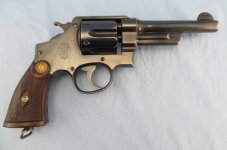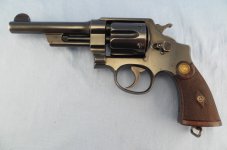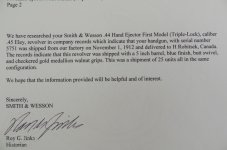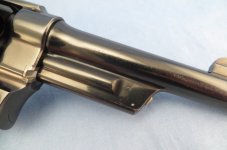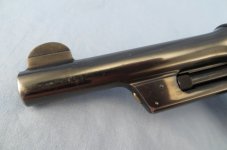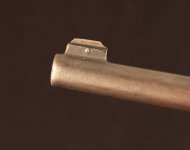You are using an out of date browser. It may not display this or other websites correctly.
You should upgrade or use an alternative browser.
You should upgrade or use an alternative browser.
Need help identifying and old S&W Revolver
- Thread starter Dolf
- Start date
Dolf, welcome to the Forum and thank you for posting such an interesting revolver. I know it is difficult to place a price on uncommon specimens, but just to offer a data point that may get a conversation going, I would think any knowledgeable collector would be willing to pay USD 3500-4000 for that revolver in that condition, and if two deep-pockets collectors clashed at auction over the question of ownership, the price could go significantly higher. I doubt that it would go into five digits (which is another way of saying that I couldn't afford it if it did), but it is definitely a specimen of some historical appeal and therefore value.
A couple of production footnotes: drift-adjustable target .455 revolvers with 7.5-inch barrels are known with serial numbers 3971 and 4060. S&W shipped the former in March 1909 (along with seven identical specimens whose serial numbers I do not know) to an individual in Birmingham, England. The latter revolver was shipped to England about three months later, but I do not know the recipient's identity or if the shipment included more than that one revolver. Other target Triplelocks bearing four-digit serial numbers in both .455 and .44 Special were shipped in 1909-1910.
As mrcvs noted above, the first military contract .455s were produced and shipped in late 1914. I have an early production specimen (serial number 358) that shipped in October of that year. A point to bear in mind is that the .455 contract revolvers were numbered in their own serial sequence, so we should expect to find duplicate serial numbers on .455 revolvers in the 3900-4400 range, with the adjustable sight guns being of earlier manufacture and the fixed sight specimens coming along about five years later. This was implicit in a comment from Hondo44 above, but I wanted to stress the fact that duplicates will exist. And to be clear, the 3900-4400 range I mentioned is arbitrary; I just used round numbers to set boundaries for the known .455 targets, however many of them there may be.
A couple of production footnotes: drift-adjustable target .455 revolvers with 7.5-inch barrels are known with serial numbers 3971 and 4060. S&W shipped the former in March 1909 (along with seven identical specimens whose serial numbers I do not know) to an individual in Birmingham, England. The latter revolver was shipped to England about three months later, but I do not know the recipient's identity or if the shipment included more than that one revolver. Other target Triplelocks bearing four-digit serial numbers in both .455 and .44 Special were shipped in 1909-1910.
As mrcvs noted above, the first military contract .455s were produced and shipped in late 1914. I have an early production specimen (serial number 358) that shipped in October of that year. A point to bear in mind is that the .455 contract revolvers were numbered in their own serial sequence, so we should expect to find duplicate serial numbers on .455 revolvers in the 3900-4400 range, with the adjustable sight guns being of earlier manufacture and the fixed sight specimens coming along about five years later. This was implicit in a comment from Hondo44 above, but I wanted to stress the fact that duplicates will exist. And to be clear, the 3900-4400 range I mentioned is arbitrary; I just used round numbers to set boundaries for the known .455 targets, however many of them there may be.
Dolf,
Thanks for the additional photos. You can probably tell comparing them to my photos I posted, of the most common factory installation,that your rear sight is exactly the same shape!
FYI" drum = cylinder, and root of barrel = frame end of barrel.
Thanks for the additional photos. You can probably tell comparing them to my photos I posted, of the most common factory installation,that your rear sight is exactly the same shape!
FYI" drum = cylinder, and root of barrel = frame end of barrel.
OP, thanks for sharing this. This forum is an education a minute. I have know there were .455 S&Ws made for British use but never knew they were made this early and in target configurations. Yes, if it came thru the Afgans, I am sure it could tell true stories much stranger than fiction !!!
"Rare misc. early commercial production 44 TL 1st Models factory chambered in .455."
Including a pre Brit Contract special order TL subset of 25 standard .44 1st Model TLs in the .44 serial # range chambered in .45 Eley with 5” barrels, shipped Nov. 1, 1912. Thx to Jim Fisher for bringing these to our attention and sharing documentation! Maybe 40 or so misc. 455s total.
A Scarce 5 Inch Triple lock shipped to Canada in April of 1915
Including a pre Brit Contract special order TL subset of 25 standard .44 1st Model TLs in the .44 serial # range chambered in .45 Eley with 5” barrels, shipped Nov. 1, 1912. Thx to Jim Fisher for bringing these to our attention and sharing documentation! Maybe 40 or so misc. 455s total.
A Scarce 5 Inch Triple lock shipped to Canada in April of 1915
All I can say is "Wow!" -as I follow along, clicking pictures and the above thread link (thanks, Jim).
What a fascinating story and journey of this TL posted by Christian, the OP.
I'd like to believe that you, the S&W cognoscenti, are preparing me for that great day when I come across my first 1st Model.
Once again, the knowledge exhibited and shared here makes this the "head-and-shoulders" greatest repository of all things Smith & Wesson!
Thank you!
What a fascinating story and journey of this TL posted by Christian, the OP.
I'd like to believe that you, the S&W cognoscenti, are preparing me for that great day when I come across my first 1st Model.
Once again, the knowledge exhibited and shared here makes this the "head-and-shoulders" greatest repository of all things Smith & Wesson!
Thank you!
I loved reading this thread. Thanks to all who contributed to my education about this unusual gun that pegs the "cool meter."
Thanks to all who contributed to my education about this unusual gun that pegs the "cool meter."
- Joined
- Mar 17, 2005
- Messages
- 26,097
- Reaction score
- 46,832
My thoughts-
That checkered trigger is almost certainly Factory. They offered checkered triggers in that period, and that is exactly how they were checkered.
That swivel is a British swivel. Find a pic of any 38 or 455 Webley revolver and compare it. I own a couple of S&Ws with the same swivels added after arriving in England.
We know that there were some 455s built long before the British military contract guns.
In 2016, I discovered the earliest 455 TL that I have knowledge of. It shipped in 1912, and it was also the first five inch 455 that any of us had ever seen. Since it went to Canada, it has no proofs of any kind---



The barrel had no caliber marks and no "Smith & Wesson"---


That checkered trigger is almost certainly Factory. They offered checkered triggers in that period, and that is exactly how they were checkered.
That swivel is a British swivel. Find a pic of any 38 or 455 Webley revolver and compare it. I own a couple of S&Ws with the same swivels added after arriving in England.
You nailed it. It is a 44 Military that was ordered in .455 caliber. Since it is #4054 of the original 44 serial number series, it may have shipped early enough for the grips to be original non medallion type. I think they fit so poorly because they have been sanded.Clearly not a military contract .455 with its 7 1/2" barrel and 4054 serial #, rather a rare misc. early commercial production 44 TL 1st Model factory chambered in .455. Maybe only about 40 or so estimated.
We know that there were some 455s built long before the British military contract guns.
In 2016, I discovered the earliest 455 TL that I have knowledge of. It shipped in 1912, and it was also the first five inch 455 that any of us had ever seen. Since it went to Canada, it has no proofs of any kind---
The barrel had no caliber marks and no "Smith & Wesson"---
Attachments
Last edited:
I've just spoken to my boyfriend again.
He bought the revolver in Kabul in 1975 for the equivalent of € 400.
the revolver was also entered in his passport, which was done at that time.
Unfortunately, he removed the color hardening that was still clearly visible from the trigger and hammer.
He also shot the revolver and found it shot high, but I think "Bisley shooting" shoots at a great distance, which would go with it.
He sends me a copy of the old passport with the entry.
Since I am very curious now, I have applied for a S&W letter.
when the letter arrives, i will post a copy.
Thank you for your kind help with identification
Best Regards
Christian
He bought the revolver in Kabul in 1975 for the equivalent of € 400.
the revolver was also entered in his passport, which was done at that time.
Unfortunately, he removed the color hardening that was still clearly visible from the trigger and hammer.
He also shot the revolver and found it shot high, but I think "Bisley shooting" shoots at a great distance, which would go with it.
He sends me a copy of the old passport with the entry.
Since I am very curious now, I have applied for a S&W letter.
when the letter arrives, i will post a copy.
Thank you for your kind help with identification
Best Regards
Christian
Let's see. Built in Springfield, Mass, shipped to Great Britain, where it was proofed for sale, probably bought by a military officer, who was later stationed in Afghanistan, where it was, most likely, either lost or stolen. Later on, it is sold in Kabul in 1975, then brought back to ?????
Quite a history. When I was in Afghanistan, 2004-2007, US citizens could only bring back pre 1899 (ATF definition of antique) firearms.
Dolf, are you and the Triple Lock here in the US?
Quite a history. When I was in Afghanistan, 2004-2007, US citizens could only bring back pre 1899 (ATF definition of antique) firearms.
Dolf, are you and the Triple Lock here in the US?
Last edited:
As an aside, and relative to the jumbled up shipping dates sometimes/often(?) seen with TL's, I'm told my 7 1/2" target #3976 is a first year gun (08), and was shipped February 23, 1909. My other, a 6.5", fixed sight (now a King Super Target) #10688 left on October 9, 1915.
Ralph Tremaine
Ralph Tremaine
Jim Watson
Member
A couple of production footnotes: drift-adjustable target .455 revolvers with 7.5-inch barrels are known with serial numbers 3971 and 4060. S&W shipped the former in March 1909 (along with seven identical specimens whose serial numbers I do not know) to an individual in Birmingham, England.
Non-S&W similarity:
Back when a free Englishman might own a revolver, I subscribed to The Handgunner, Ltd. One of their regular dealer advertisers showed a picture of the company team with their six consecutive numbered Webley WS Target revolvers. They were 7 1/2" squarebutts, like a long Mk VI.
He also shot the revolver and found it shot high, but I think "Bisley shooting" shoots at a great distance, which would go with it.
Probably zeroed for a six o'clock hold which would look high if he expected it to shoot to point of aim.
What I only became aware of today, the revolver has a barrel length of 7 1/2 "the military British had 6 1/2" right?
Then it would definitely have to be a civilian versoin before the military production?
Best regards
Christian
Then it would definitely have to be a civilian versoin before the military production?
Best regards
Christian
Welcome to the forum! And that’s an impressive first post. I believe what you have is a Military Target revolver. The rear sights are drift adjustable to meet the match requirements. Hondo44 will be along to give you much more details about these revolvers. Very neat old gun.
Dolf,
Yes, the gun you show is a civilian model from well before the British 6 1/2" barrel military revolver order.
I'm afraid your misunderstanding of the term used above, "Military Target revolver" had confused you early in the thread: the term "Military Target" refers only to the factory sight installation, the revolver is not a military revolver.
Please review post 16:
Dolf,
Clearly not a military contract .455 with its 7 1/2" barrel and 4054 serial #, rather a rare misc. early commercial {civilian} production 44 TL 1st Model factory chambered in .455. Maybe only about 40 or so estimated.
The few .455s ordered before the BSRs {British WWI military service revolvers} were typically ordered for Bisley matches in England and therefore with Bisley match rule conforming improved sights. Since S&W's adjustable target sight did not conform, they accommodated the need as I believe they did with your gun. They are often referred to as the "Military Sight", they have nothing to do with the military and I call them "Bisley Sight".
Hope this helps,
Last edited:
Dolf, that's correct. The few non-military .455 target models had 7.5" barrels and were manufactured four to five years before the first military contract .455s with fixed sights and 6.5" barrels went into production.
The proof marks on the barrel look like the crown-above-BV type, which are one of the many known Birmingham proofs. One in your photograph is legible despite being slightly blurry. The other is more blurred, but looks as though it may be a weakly struck imprint from the same stamp.
As to shooting high, I am not surprised. The front sight on .455s is quite tall on the fixed-sight models that have the in-frame rear notch. The drift-adjustable rear sight has a notch that is slightly higher than the frame notch, so the front sight would need to have a corresponding increase in height in order to maintain the proper impact point of the bullets fired from the revolver. Instead, the front sight is much lower than the standard fixed-sight height. Such a configuration may be appropriate for long-range competitions, but it is a prescription for hitting high when shooting at closer targets. Since the front sight is removable, it can be replaced with a taller sight for use at shorter distances.
Now that I think of it, can you ask your friend to take close-up photos of the front sight from the side, top, and angling down on it from a little above, behind, and off to the side? I'm wondering if it is possible that the site is damaged and that a top mounted white or brass bead may have been broken off.
EDITED TO ADD: I see that Jim got his comments posted first, which often happens when we both want to say something about a specific point. I used to be able to type faster than I do now.
The proof marks on the barrel look like the crown-above-BV type, which are one of the many known Birmingham proofs. One in your photograph is legible despite being slightly blurry. The other is more blurred, but looks as though it may be a weakly struck imprint from the same stamp.
As to shooting high, I am not surprised. The front sight on .455s is quite tall on the fixed-sight models that have the in-frame rear notch. The drift-adjustable rear sight has a notch that is slightly higher than the frame notch, so the front sight would need to have a corresponding increase in height in order to maintain the proper impact point of the bullets fired from the revolver. Instead, the front sight is much lower than the standard fixed-sight height. Such a configuration may be appropriate for long-range competitions, but it is a prescription for hitting high when shooting at closer targets. Since the front sight is removable, it can be replaced with a taller sight for use at shorter distances.
Now that I think of it, can you ask your friend to take close-up photos of the front sight from the side, top, and angling down on it from a little above, behind, and off to the side? I'm wondering if it is possible that the site is damaged and that a top mounted white or brass bead may have been broken off.
EDITED TO ADD: I see that Jim got his comments posted first, which often happens when we both want to say something about a specific point. I used to be able to type faster than I do now.
Last edited:
Similar threads
- Replies
- 1
- Views
- 482
- Replies
- 10
- Views
- 1K
- Replies
- 12
- Views
- 1K
- Replies
- 6
- Views
- 753
Latest posts
-
-
-
-
-
-
-
-
-
-
-
FINLAND - The Winter War 1939 -> NATO member 2023 - general matter about Finland
- Latest: S&WshooterFIN
-

